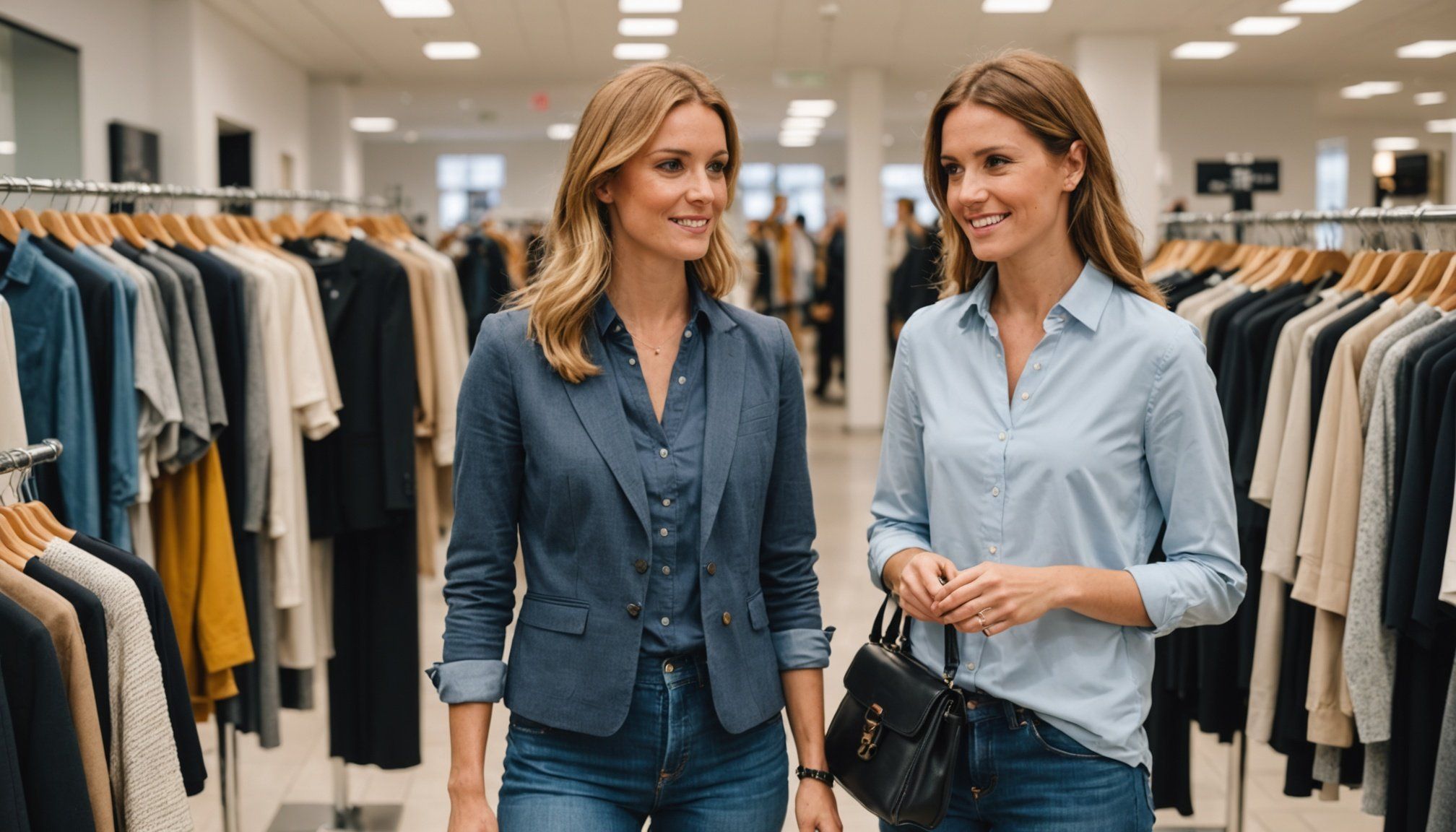Revolutionizing UK Retail: Elevate Sales and Slash Returns with Virtual Try-On Technology
In the ever-evolving landscape of UK retail, one technology is standing out for its potential to transform the shopping experience, boost sales, and significantly reduce return rates: virtual try-on technology. This innovative tool is not just a gimmick; it’s a game-changer that is redefining how customers interact with products online and in-store.
The Rise of Virtual Try-On Technology
Virtual try-on technology, often powered by augmented reality (AR) and artificial intelligence (AI), allows customers to see how products look on them without the need for physical try-ons. This technology is particularly popular in the fashion and beauty sectors, where fit and appearance are crucial.
Also to see : Maximizing UK Retail Success: Top Omnichannel Approaches to Enhance Customer Satisfaction
For instance, UK high street giant Next has recently partnered with Vyking to introduce a virtual shoe try-on service on its mobile app. This allows shoppers to virtually try on over 200 pairs of shoes, enhancing their shopping experience and reducing the uncertainty associated with online purchases[1][5].
Benefits for Customers
Enhanced Customer Satisfaction
Virtual try-on technology significantly enhances customer satisfaction by providing a more accurate and personalized shopping experience. Customers can see how products look on them in real-time, reducing the guesswork and leading to more confident buying decisions.
Also to read : Critical Data Privacy Tactics for UK SMEs in Global Transactions: A Comprehensive Guide
“Virtual try-ons help significantly reduce return rates by enabling customers to visualize products more accurately, thus decreasing the likelihood of dissatisfaction,” notes a report from Rocket Alumni Solutions[2].
Reduced Return Rates
One of the most significant benefits of virtual try-on technology is the reduction in return rates. When customers can see how a product fits and looks before purchasing, they are less likely to return it. According to Webelight, virtual try-on technology can reduce return rates by up to 64%[4].
Increased Sales
Implementing virtual try-on tools has been shown to boost sales conversions. Customers are more likely to make a purchase when they can try products virtually and feel confident about their choices. A study by Perfect Corp. found that retailers saw a 2.5 times increase in sales conversion after implementing virtual try-ons[2].
Benefits for Retailers
Increased Sales and Revenue
By offering virtual try-on experiences, retailers can increase sales and revenue. This technology alleviates the hesitation and uncertainty associated with online shopping, leading to higher conversion rates. For example, Shopify reports a 94% growth in sales for businesses that implement virtual try-on technology[4].
Reduced Costs
Virtual try-on technology can also deliver cost savings for businesses. It reduces the need for physical samples, inventory holding costs, and showroom expenses. Additionally, it contributes to a more sustainable business model by minimizing the waste and environmental impact associated with traditional retail practices[4].
Competitive Advantage
In a competitive market, retailers that adopt virtual try-on technology differentiate themselves from their competitors. Currently, only about 1% of retailers use AR in their e-commerce businesses, making early adopters stand out as industry leaders[4].
How Virtual Try-On Technology Works
Real-Time Rendering and 3D Models
Virtual try-on technology often involves real-time rendering of 3D models, providing customers with a detailed and interactive view of products. For instance, a customer shopping for shoes can use VR technology to see how the shoes look on their feet in real-time[4].
Accurate Size and Fit Measurements
This technology helps users accurately measure and assess the size and fit of products before making a purchase. Clothing retailers can offer virtual dressing room experiences where customers can see how different sizes and styles look on a customizable avatar[4].
Customizable Avatars and Digital Twins
AR technology enables the creation of customizable avatars and digital twins, allowing users to personalize their online shopping experience. A beauty brand might offer customers the ability to create a virtual representation of themselves to try different makeup looks before buying[4].
Case Studies: Success Stories in UK Retail
Next and Vyking
Next’s partnership with Vyking is a prime example of how virtual try-on technology can enhance the shopping experience. By integrating 3D viewer and virtual try-on solutions on its mobile site, Next allows shoppers to see and try on over 200 pairs of shoes. This initiative is expected to expand further in 2025 with more 3D models and additional product categories[1][5].
Marks & Spencer
Marks & Spencer introduced AR to assist customers in visualizing how furniture would fit in their homes. By offering a virtual placement tool through smartphones, they seamlessly connected augmented reality with their traditional retail environment, seeing a notable boost in customer engagement and sales[3].
Topshop
Topshop piloted an AR-based virtual dressing room, allowing shoppers to ‘try on’ clothing without physically changing. This addressed consumer hesitance and offered a practical solution to changing room queues, enhancing the overall shopping experience[3].
Future Predictions for Virtual Try-On Technology
AI-Powered Experiences
The future of virtual try-on technology is heavily influenced by advancements in AI. AI can analyze data to provide more accurate and personalized recommendations. For instance, Deloitte found that retailers using AI and AR see a 40% increase in conversion rates. By learning from user preferences and past behaviors, AI can suggest products that fit not only in size but also in style and color[2].
Personalized Shopping
Imagine shopping online and feeling like you have a personal stylist. With virtual try-on technology, this is becoming a reality. AI can customize the shopping experience by recommending products that match your unique style and needs. According to Kevin Nicholas, AR and AI can sense skin tone and shape to suggest clothing and makeup, enhancing personalization[2].
Challenges and Limitations
While virtual try-on technology offers numerous benefits, there are also some challenges and limitations to consider.
Technical Hurdles
Ensuring cross-platform compatibility and maintaining up-to-date software are significant technical hurdles. However, as the technology evolves, these challenges are being addressed, and the overall user experience is improving[3].
Cost of Implementation
Implementing virtual try-on technology can be costly, especially for smaller retailers. However, the long-term benefits, including increased sales and reduced return rates, often outweigh the initial investment[4].
Practical Insights and Actionable Advice
For retailers considering adopting virtual try-on technology, here are some practical insights and actionable advice:
- Start Small: Begin with a limited range of products to test the technology and gather feedback from customers.
- Invest in High-Quality 3D Models: High-quality 3D models are crucial for providing an accurate and engaging virtual try-on experience.
- Integrate with Existing Systems: Ensure that the virtual try-on technology integrates seamlessly with your existing e-commerce platform and supply chain.
- Monitor and Analyze Data: Use data analytics to understand customer behavior and preferences, and to continuously improve the virtual try-on experience.
Table: Benefits of Virtual Try-On Technology
| Benefit | Description | Impact |
|---|---|---|
| Customer Satisfaction | Enhances customer satisfaction by providing accurate product visualization. | Increased customer confidence and loyalty. |
| Reduced Return Rates | Reduces return rates by allowing customers to see how products fit before buying. | Cost savings and reduced logistical burdens. |
| Increased Sales | Boosts sales conversions by alleviating online shopping uncertainties. | Higher revenue and market competitiveness. |
| Personalized Shopping | Offers personalized product recommendations using AI and AR. | Enhanced customer engagement and satisfaction. |
| Cost Savings | Reduces the need for physical samples and inventory holding costs. | Improved profitability and sustainability. |
| Competitive Advantage | Differentiates retailers from competitors by offering innovative shopping experiences. | Attracts new customers and retains existing ones. |
Virtual try-on technology is revolutionizing the retail landscape in the UK by offering customers immersive, personalized, and engaging shopping experiences. With its ability to enhance customer satisfaction, reduce return rates, and increase sales, this technology is a must-consider for any retailer looking to stay ahead in the competitive e-commerce market.
As Thibault Marion de Procé, Co-founder and CPO at Vyking, noted, “Looking ahead to 2025, we’ll continue to expand with more 3D models, additional product categories and ultra-personalised shopping experience.” This vision for the future underscores the potential of virtual try-on technology to continue transforming the way we shop, making it an exciting time for both retailers and consumers alike[1].






